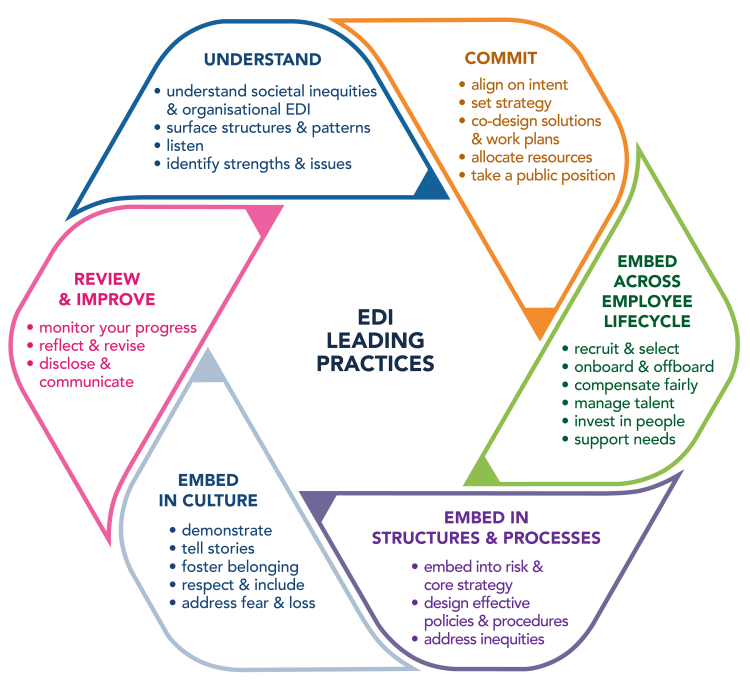Inclusive Workplace Culture: The Case for Integrating EDI Across Your Organisation
Share this post on:LinkedIn

Image by Vlad61 on Shutterstock
A growing number of companies are interested in understanding how to effectively support workplace equity, diversity, and inclusion (EDI) and foster a more inclusive culture that attracts and helps retain the workforce they need.
In response to this growing interest, we consulted leading research and spoke with organisations in a range of industries and geographies to better understand the practical steps that companies are taking to support more equitable, diverse, and inclusive workplaces –where their workforce feels welcome, that they belong, and that they are treated fairly.
We capture our key insights below, to offer some direction to companies embarking or advancing on their own EDI or workplace culture journeys and share actions that organisations can take to improve EDI in their own workplaces.
Workplace Equity, Diversity, and Inclusion
Workplace EDI is a rapidly evolving space.
Many organisations that began with a focus on setting diversity-related targets have quickly recognised the need for culture change efforts to foster inclusion (D&I or I&D) and address challenges with retention and wellbeing that are common to diverse but non-inclusive workplaces. Over time, it became clear that strategic investments focused on shifting processes and structures would be necessary to address barriers to workplace equity, shifting the focus to EDI or DEI.
More recently, as organisations develop a deeper understanding of the impacts of workplace culture, they are broadening their focus to address issues of justice (JEDI), access or ability (IDEA), belonging (DEIB), reconciliation (DEIR), or other relevant combinations of these concepts.
Practical steps for change
Our new EDI Leading Practices Guide offers a framework of key practices to guide the development and implementation of robust company-wide EDI strategies and programs. The framework provides an iterative and (somewhat) cyclical pathway for your company to enhance its EDI program for impact, no matter if you are just beginning on your journey or already have an established foundation of existing efforts.
Below, we highlight some of the practices that can be most useful to support effective culture change efforts.

Listen
Understanding employee’s experiences is key to developing an EDI program that meets your organisation’s underlying needs.
Proactively seek input from your workforce to gain key perspectives on your workplace culture, on employee experiences, and on the effectiveness of your current initiatives. This can be done with formal feedback mechanisms, employee surveys, culture audits, or more informal methods such as town halls or open-door policies. This should be paired with mechanisms to protect those who speak up, ensuring that employees feel safe bringing up any concerns they may have.
Your EDI program should also be guided by engagements with key knowledge holders, which may include internal bodies such as employee resource groups (ERGs) and relevant external organisations or community groups that may be sources of important insight.
Invest in People
Equipping your employees with the knowledge and competencies they need to understand and support your EDI strategy is key to bringing your entire organisation along on the journey.
Invest in people by making resources and training readily available, supporting learning (and unlearning) as needed. Integrate EDI capabilities and concepts into leadership training to amplify the ability of leadership to cultivate and enact change. Make sure these learnings take place in alignment with your other EDI efforts, and not as your sole intervention.
Model Behaviour
Leaders play an integral role in ensuring that the cultural changes your organisation aspires to take root in meaningful ways. The daily actions and behaviours that they model can send powerful messages about workplace expectations that set the stage for others to follow.
Encouraging executives and people managers to take visible actions that reinforce a fair, inclusive, and respectful work environment helps to signal that key behaviours, including accountability, kindness, and allyship, are important building blocks of your culture.
Address Fear and Loss
EDI programs can sometimes be met with feelings of fear and loss from privileged identities, particularly if there is a sense that something is being taken away from them. Even if left unvoiced, it is very likely that these feelings exist, and they must be acknowledged as part of the change process.
Meet individuals where they are. Acknowledge that cultural change is a lifelong learning journey and the fear of doing or saying the wrong thing can often put people on edge. Invite and include privileged identities in discussions on equity and inclusion, as long as their engagement remains respectful, and provide spaces for mutual learning. Offer opportunities that allow privileged identities to explore and understand the systems that have shaped their experiences in comparison to others. Address any resistance with patience and understanding, but remember to remain firm on the requirement for your organisation’s EDI strategy.
Fit-for-purpose EDI
It's important to remember that there are no one-size-fits-all solutions for EDI programs. This journey will look different in each organisation. Mould these practices to fit your organisational context – take the time to understand your organisation and assess what would be most helpful for driving change in your workplace.
Consider where your organisation needs to focus at its current stage of the EDI journey. Should you surface your structures, listen to employees, and gain a deeper understanding before you begin this work? Or are you at a place where capacity building and addressing fear and loss on the part of employees is the key to spurring meaningful culture change?
We found that organisations that appear to be making more progress on EDI are typically engaging in longer-term companywide cultural change journeys that require broad leadership support, new capabilities, a receptive environment, and frequent stock-taking and course-correction. That’s why we structured our guide as an iterative and (somewhat) cyclical portfolio of practices that starts with cultivating the foundational knowledge your company will need to start its EDI journey. We encourage you to explore the EDI process in our guide and enter into the process and the practices wherever it makes the most sense for your organisation based on your efforts to date.
Further resources
If you’re ready to embark on or enhance your organisations EDI journey, explore our full EDI Leading Practices Guide for key practices, examples, and resources for every stage of the journey.
You may also want to explore the range of other guides we have on supporting change in your organisation, including Becoming an Agent of Change, Being an Effective Change Agent, and Supporting Your CEO for impactful organisational change.
Footnotes
Image by Vlad61 on Shutterstock.